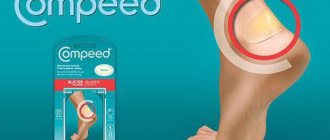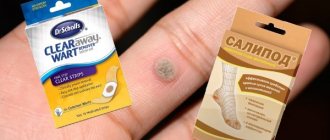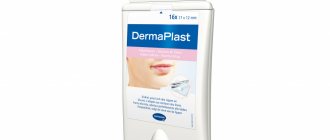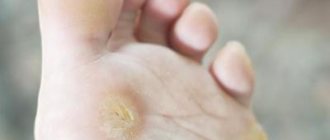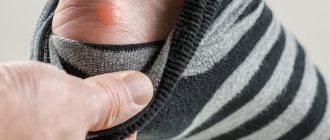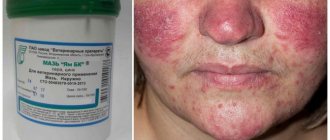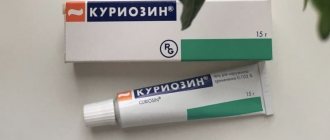Composition and release form
The thin polyurethane base gives the product wear resistance and makes it possible to use it with different types of shoes. Therapeutic and hygienic products are made from lightweight polymers, which makes the patch practically imperceptible on the body.
Compeed are highly elastic, do not wrinkle and are able to take any configuration, exactly following the contours of the leg. They help to avoid discomfort and pain when breaking in new shoes or boots.
The action of the product begins almost instantly after gluing. Compeed is water-resistant, so even when wet, the fixation on the surface of the skin does not weaken. It is well ventilated and accelerates the healing of any dermatological destruction.
Compide is a patch for wet calluses that effectively anesthetizes the damaged surface of the epidermis and prevents wound infection. Hygienic products are produced in the form of adhesive polymer flaps of various geometric configurations and dimensions or small disks.
The composition of the patches depends on the type and purpose of the product.
All models contain the following components:
| Substance | Description and functions |
| Gum | An adhesive layer based on a high-molecular carbon compound of natural origin. |
| elastomer | Polymer of high elasticity, resilience and viscosity. Gives the patch flexibility. |
| plasticizers | They facilitate the dispersion of components and increase the product’s resistance to low temperatures. |
| Hydrocolloid elements | Hydrophilic polymers that maintain a moist environment on the damaged skin area and accelerate wound healing. |
| polyurethane | Heterochain plastic material that gives Compid resistance to abrasion. |
| Plant resins | Makes the patch waterproof and dust-repellent. |
This composition gives Compeed patches hygienic, bactericidal, and ventilation properties. Under the influence of the product, calluses first decrease in size and then completely disappear.
Kinds
Johnson & Johnson produces adhesive medical and hygiene products for various purposes.
There are 6 types of Compid patches:
- Medium Callous – for corns. The product contains special healing components of natural origin that effectively affect the surface and deep layers of the epidermis and have a softening effect. Approximate price – 180 rubles.
- Corn plasters – for dry calluses. The components that make up its chemical formula eliminate keratinization of the skin, relieve redness and inflammation. The approximate cost in Russian pharmacies is 160 rubles.
- Soothing Blister Relief – for blisters and wet calluses. The composition is saturated with special drying ingredients. The product has a breathable structure, absorbs liquid well, and prevents the development of pathogenic microflora in the destructive zone. For a pack of 6 pcs. in a Russian pharmacy you will have to pay about 260 rubles.
- Active Corn – against ingrown and deep calluses. The patch saturates the epidermis with nutrients and analgesics, simultaneously softening and moisturizing it. The remedy relieves pain and eliminates old destruction of the epidermis. Price for a pack of 5 pcs. is 250 rubles.
- Compeed Pencil is a preventive patch that prevents the formation of calluses of any type. Creates a thin protective film on the skin surface, which reduces friction when wearing new shoes. Price – 290 rub.
- Total Care Invisible Cold Sore Patch – against herpes and other bacterial infections. It is distinguished by the presence of antiseptic properties. Price – 300 rub.
Compid is a patch for wet calluses and other types of destructive changes in the epidermis, which should be used only for its intended purpose.
Purpose
Each package of hygiene products is supplied with instructions for use. It indicates what type of callus the product is intended for. Compid effectively eliminates destructive formations of various etiologies and localizations.
Indications for use:
- keratinized layers;
- deeply ingrown calluses;
- abrasions between the toes, on the heel, on the foot;
- epidermal cracks;
- exudate-filled and inflamed areas of the skin;
- growths;
- bacterial and fungal infections.
The Compid line of hydrocolloid products prevents dust particles, dirt, and any foreign elements from entering open wounds. The patch protects damaged areas of the epidermis from mechanical pressure, temperature and chemical influences.
Compid
A popular medicine for preventive and therapeutic use. It has a natural composition, the drug is safe to use and does not cause allergies. After application, the skin of the feet becomes softer, moisturized and mechanical impact on the feet when wearing any shoes is eliminated.
Does not leave any marks on clothes, is quickly absorbed, forming a thin coating that does not wash off throughout the day.
Almost immediately after use, pain is relieved and chafing is prevented.
It is recommended to use daily, applying the pencil to a clean area of the feet.
Contraindicated in the following cases:
- Allergic reactions.
- Wound on the skin.
- Formed calluses and blisters.
- Some dermatological diseases.
The cost of the drug is on average 300 rubles.
Contraindications
The product is well tolerated by people with any skin type and a tendency to allergic reactions. However, there are some clinical contraindications for use.
These include:
- hypersensitivity to the components of the patch;
- deep cuts in the skin, if the active ingredients of the colloidal product get into them, they can cause burning or itching;
- severe diabetes mellitus and other endocrine disorders requiring prior consultation with a doctor;
- chronic dermatological pathologies in the area of application;
Do not apply the product after its expiration date.
Callus
Calluses can be especially painful. In the center of the callus there is a hole from which the head of the callus protrudes. This head covers the root, which goes deep into the soft tissues and causes pain when walking.
Such a callus can form as a result of a foreign body (for example, a splinter or a pebble) getting under the skin. If the splinter is not removed, when it moves, it begins to irritate the tissues surrounding it, and the body, in response to irritation, forms a corpus callosum, but not from the outside, but from the inside. Another reason for the appearance of calluses is a dermatotropic virus.
Operating principle
The colloidal product softens the skin, gives it a healthy appearance and elasticity. The patch quickly absorbs exudate, drying the open wound. The chemical formula of the hygiene product for dry calluses contains salicylic acid, which is applied to the central part of the tape.
The substance comes into direct contact with the damaged area of the skin.
The medicinal product contains components that have the following effects:
- reduce pain from calluses, abrasions, and wounds on the legs;
- facilitate walking in case of destruction of the epidermis;
- moisturize rough areas of the skin;
- accelerate the healing of cuts;
- eliminate fungal infections;
- suppress the activity of pathogenic microorganisms.
After gluing the tape, salicylic acid is released and penetrates into the deep layers of the destructively altered area, restoring the natural structure of the epidermis. Additionally, the product softens tissue, blocks the wound surface from the external environment and relieves pain.
Compide is a patch for wet calluses that prevents the emergence of pathogenic microflora, since it creates unfavorable conditions for its development. Under the influence of biologically active components, healing of damaged areas occurs as quickly as possible.
In destructively altered tissues, cellular regeneration processes are launched. Special polymer components of the patch simultaneously polish the skin, giving it smoothness and removing keratinized elements from the surface.
The polyurethane base of the colloidal product provides free access to the damaged area of the air mixture. Due to such natural ventilation, diaper rash does not form.
Advantages
The treatment eliminates destructive formations on the skin, rather than masks them.
The main advantages of Compeed patches:
- rapid absorption of exudate from the wound surface;
- flesh-colored ribbon can be worn discreetly, which does not cause difficulties for women when wearing sandals or open shoes;
- the special design of the product ensures proper ventilation, good heat exchange, and effectively removes sweat;
- special components of the chemical formula of the product prevent the appearance of unaesthetic scars at the site of a healed wound;
A variety of shapes and sizes ensures the comfort of using Compeed patches. The colloidal product is characterized by high strength, abrasion resistance, and dust-repellent properties.
Therefore, you can wear it for a long time until the calluses are completely healed. When used and in constant contact with tight shoes, the adhesive tape does not roll or crumple.
This prevents re-injury of the protected surface of the skin. The thin patch is not felt at all on the body and causes not the slightest discomfort. Absolute waterproofness allows you not to remove the product in the bath or shower.
This property also protects the open wound from excessive moisture and exposure to shampoo and soap, which can cause irritation of the injured area, unpleasant itching, and burning. The Compeed patch allows you to do without other medications and antiseptics.
Advantages of “second skin”
The unique properties of hydrocollodide polymers determine the advantages of using Compid patches. The advantages of the products in question are as follows:
- Completely eliminate pain caused by friction and mechanical pressure. This feature is ensured due to the density and strength of the material, as well as the sufficient width of the patch.
- Stays securely on the skin and does not roll off for 24 hours. Unlike ordinary patches, Compid is not afraid of water.
- Provides rapid healing of the wound surface.
- Relieves pain.
- Protect the wound from dirt and germs, allowing the skin to breathe.
- Softens dry calluses and makes them easier to remove.
- Thanks to their transparency, they are almost invisible on the skin, which allows them to be used when wearing open shoes.
- The range of plasters allows you to choose the desired size and shape.
Taking into account which area is susceptible to damage, the manufacturer has developed patches that are optimally suited to a specific toe or area of the foot.
Of course, a regular adhesive plaster is significantly inferior to the option under consideration. The Compid patch (reviews repeatedly confirm its effectiveness) is a completely new approach to the treatment of skin lesions. Nevertheless, many consumers are wary of fairly expensive new products, preferring the more familiar, cheap adhesive plasters. How much do Compid patches cost, and what do users think about them?
How to choose the right patch?
The variety of options for such products allows you to purchase the product in accordance with the nature and type of dermatological destruction. But at the same time, this makes the choice much more difficult.
When purchasing Compeed patches, you should be guided by:
- type of calluses;
- localization of education;
- physicochemical characteristics of damage.
To make the task easier for ordinary consumers, the manufacturer indicates on the packaging in large print the purpose of the colloidal adhesive pads. The main thing is to independently determine the type of skin damage that needs to be eliminated.
Compid patches are available for wet calluses, dry calluses and others. Depending on the area of application, you can select a therapeutic and prophylactic sticker of the desired shape and size.
There are patches designed specifically to eliminate calluses and abrasions in the interdigital area of the feet. Such products have increased wear resistance and have a special geometrically precise configuration.
They are poorly suited for use on other areas of the legs. This applies to the entire range of Compeed patches. Such products should not be used for other than their intended purpose.
In this case, their effectiveness will be quite low. The correct choice of a patch will prevent it from slipping during use and will ensure the most effective effect on the type of dermatological destruction for which it is designed.
Reviews
There are many reviews about this product published on the Internet. And in most cases they are positive. “Compid Patch” is a real lifesaver for people leading an active lifestyle, as well as those whose work is mobile. It quickly relieves pain and heals damaged skin, which is very important in the summer.
Words of gratitude are left by users who have used the antiherpetic patch from this manufacturer. Reviews confirm its effectiveness against herpes on the lips, which allows you to quickly eliminate the signs of the disease and return to your previous life.
One of the negative aspects is the high cost of the patches.
Mode of application
To achieve the proper therapeutic effect, you must follow the manufacturer's recommendations. For each type of patch, they differ according to the purpose of the colloidal products.
General step-by-step instructions for use:
- It is necessary to clean and dry the wound surface.
- Then the patch must be heated in your hands to the temperature of the human body in order to activate the active ingredients of its formula and avoid discomfort when sticking.
- The product is applied to the center of the lesion and slightly smoothed towards the edges.
- It is necessary to lightly move your fingers over the patch to remove air sinuses until there is a tight adhesion to the surface of the skin.
If applied carelessly, when the active ingredients of the colloidal product do not reach the affected area, skin irritation or mild itching is possible. This occurs due to the acute reaction of healthy tissues to the action of the active components of the patch.
For wet calluses
This product is coated with a substance with bactericidal properties and increased hygroscopicity. Its active ingredients prevent drying of the damaged skin area.
Recommendations for use:
- The surface of the epidermis is treated with warm water and chemically neutral toilet soap.
- Clean the edges of a wound filled with exudate from keratinized fragments
- The skin area is dried.
- Remove the protective film from the patch and apply it tightly with the adhesive side to the damaged area.
The absorption of exudate is noticeable by a wet spot on the back of the colloidal product. The patch must be applied carefully and always the first time.
Otherwise, the sticky layer will further damage the wound, which will cause pain.
For dry calluses
When this type of destructive changes occurs in the skin, it is important to use the Compeed patch in a timely manner. It moisturizes the wound and softens keratinized tissue thanks to the hydrocolloid component included in its composition. A special polymer coating provides reliable adhesion to the skin surface and prevents premature peeling.
How to use the product:
- First you need to steam your feet in hot water with sea salt.
- Then you should wipe the skin dry with a towel and gently blot the damaged area.
- Next, the patch is heated in your hands and the protective film is removed from its sticky side.
- Apply the tape or disc tightly to the damaged area.
Compide (a patch for wet or dry calluses) is used in almost the same way. It is important that the active substance gets exactly into the place intended for therapeutic effect. Dry calluses will soften in about 2 days and begin to gradually disappear.
For corns on the soles
This product contains in its multilayer design a special gel-like component with analgesic properties and the ability to penetrate the internal structure of the destructive area. The patch instantly relieves pain and quickly moisturizes the epidermis.
You need to use it as follows:
- First, the skin is steamed in a bath with a solution of hot water, table salt and baking soda.
- Use a pumice stone or a special cosmetic brush to remove dead layers.
- Then the surface of the skin intended for therapeutic treatment is dried.
- Remove the protective film from the patch.
- The colloidal product is pressed tightly with the adhesive side to the corn.
Within 2-3 days, the callus will begin to decrease in size, and the natural structure of the epidermis will be restored. Complete healing is observed after a week. The salicylic acid included in the therapeutic product moisturizes keratinized layers, and sulfur compounds dissolve and remove them.
For ingrown calluses
Hydrocolloid components create a moist mineral environment in and around the body of the rod. Vitamin supplements and bioactive elements accelerate cell regeneration. Therefore, ingrown calluses quickly disappear naturally.
Before applying the patch, the skin must be thoroughly steamed and carefully treated with a pumice stone or a cosmetic scraper. Then the surface of the epidermis is thoroughly dried.
Apply the patch after removing the protective coating from its adhesive side. The colloidal polymer provides a kind of greenhouse effect in the callosal formation, due to which it gradually collapses. The product prevents the formation of cracks and eliminates pain.
For herpes
The active ingredient of this patch is hydrocolloid-075, which effectively absorbs wound secretions.
Auxiliary components:
Compid antiherpetic patch
- gelatin is a partially hydrolyzed collagen protein of animal origin, which restores the natural structure of affected epithelial cells;
- croscarmellose sodium - a chemical compound with a high ability to absorb exudate;
- plant resins that perform a barrier function;
- a polyurethane base that ensures the tightness of the active components of the patch.
The therapeutic agent protects the wound from external influences and bacterial colonization. The Compeed anti-herpes patch is a transparent film that is completely invisible on the body.
It can be glued to the face by applying makeup on top, which adheres perfectly due to the high adhesive properties of polyurethane. It is recommended to use a colloidal product at an early stage of a dermatological disease - at the first signs of herpes.
In this case, the Compeed patch demonstrates the greatest effectiveness, quickly extinguishing the inflammatory process and destroying pathogenic microflora in the phase of its development. Before gluing the product, it is necessary to wash the affected area of skin with toilet soap or antiseptic cosmetic milk, and wipe thoroughly with a towel or napkin.
Special instructions for use
Before purchasing a patch, you need to accurately determine the type of callus formation and its location. The appropriate type of remedy depends on this. The patch should not be applied to a freshly washed surface.
It must first be wiped and degreased to ensure high-quality adhesion of the adhesive layer to the skin and create a tightness in the wound hole. When using an antiherpes drug during pregnancy and lactation, medical consultation is required.
It is forbidden to tear off the bandage from the wound. This will lead to its opening and the risk of suppuration. Do not cover the patch with antiseptic ointments, creams, or disinfectant lotions. Otherwise, the effectiveness of the therapeutic effect will sharply decrease.
The product peels off on its own after completion of the treatment procedure and the consumption of its active ingredients. The Compid patch for wet, dry or ingrown calluses acts in a similar way and falls off without outside intervention.
Article design: Vladimir the Great
How to properly use a pencil for calluses
To get the maximum benefit from the drug, it should be used correctly:
- The pencil acts as a preventative against chafing feet. Therefore, it cannot be used for already formed calluses and corns. In this case, it is advisable to use a patch and products with a healing effect.
- The medicine is applied to clean feet. They are first washed with soap and water and dried thoroughly.
- The pencil is applied thinly to places where there is a high risk of physical contact between the skin and shoes; 1 layer is sufficient.
You don't have to wait until after use. The product dries quickly. If necessary, you are allowed to wear socks, tights, or immediately put shoes on your bare feet.
